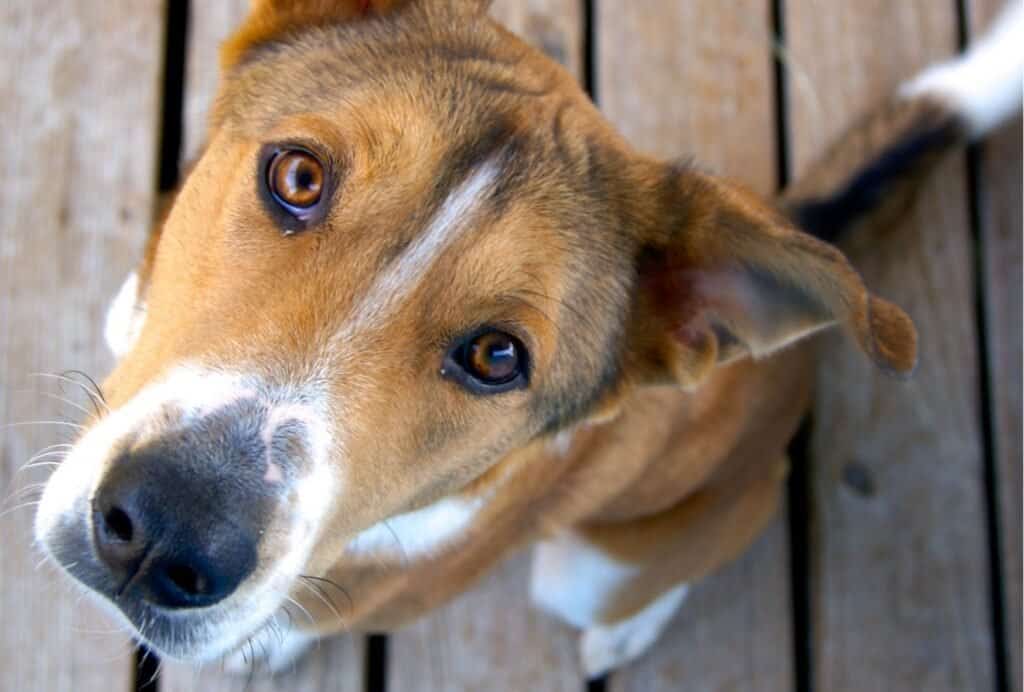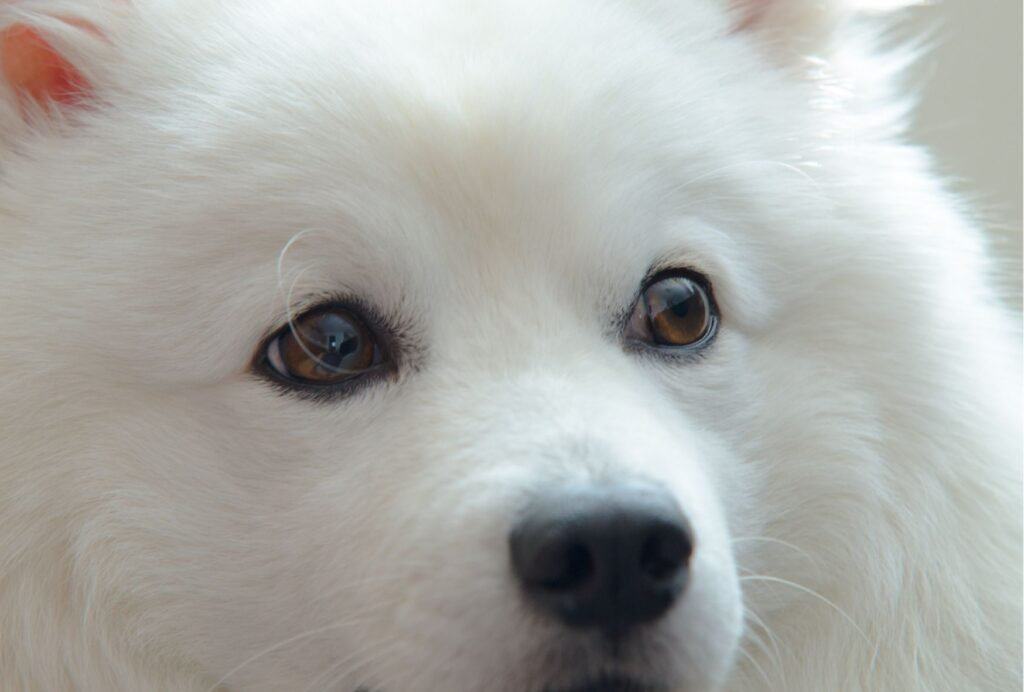You’ve probably noticed a little bit of goo in the corners of your dog’s eyes, or around them. Most dogs will at some point have discharge like this. But you’re probably wondering what it even is in the first place!
Dogs can get eye boogers for a variety of reasons. Most of the time, it’s entirely natural, normal, and nothing to worry about.
Sometimes, however, your dog’s eye boogers can indicate a larger problem. It’s rare, but if your dog’s eye discharge seems to be excessive or an odd color, that can signify something else is going on.
Before we get into why your dog might have eye boogers, take a look at these related articles that also have to do with your dog’s health:
- Why Do Dogs Drag Their Butts on the Floor? Scooting Explained
- Why Your Dog Has a Noisy Stomach and What to Do About It
- Why Is My Dog Sniffing the Air?
Table of Contents
Why do dogs have eye boogers?
Okay, so let’s look at this question in more detail. There are a couple of reasons why dogs have eye boogers.
Here are the most common ones.
Normal discharge
Have you ever woken up in the morning and wiped away crusty little eye boogers when you rubbed your eyes? It’s normal for both yours and your dog’s eyes to secrete a little discharge throughout the day.
Eyes are self-cleaning. The little bit of normal discharge that comes out of them are the tear ducts draining and getting rid of debris from the eye area.
If your dog just has a little clear or brownish discharge or crust around the eye, it’s likely totally normal. This type of discharge should be easily cleaned up with a damp cloth.
Infection
If you find that the discharge around your dog’s eyes is excessive or an odd color, then it’s possible your dog has an eye infection. You may find that this type of discharge is cloudy or a yellowish color, indicating that there is pus in it.
If this is the case, then there will usually be other signs that show there is the problem. For example, you may find that your dog’s eye is red, or that the eyelids are swollen.
Another sign is that he may paw at his eye because it’s itchy or painful.
If you think your dog might have an eye infection you should take him to the vet to get checked out.
Allergies
Just like humans, some dogs get allergies!
A dog’s allergies can be triggered by a variety of things. Some dogs are allergic to the food they eat, while others get contact allergies. Many dogs also experience airborne allergies.
Whatever the source of the allergies, watery and running eyes can be a significant symptom of this issue.
If you suspect that your dog has allergies, your vet will be able to help you determine what they are. They’ll also be able to help you find ways to manage your dog’s allergies.
Dry eyes
Your eyes are naturally always wet. Or at least, they should be! The same is true for your dog’s eyes. Moisture in the eyes keeps your eyes and your dog’s safe. But sometimes eyes can get dry.
Dogs who have dry eyes may find them itchy and sensitive to light. You might also notice that your dog’s eyes are red. There may also be more discharge than usual around the eye.
A dog’s dry eyes can be caused by a number of issues. It might be an autoimmune-related disorder, or the sign of an infection.
If your dog seems to have chronic dry eyes, then a trip to the vet might be in order.
Breed specific issues
Some breeds naturally secrete more eye boogers than other breeds. Breeds that are more bug-eyed will tend to secrete more discharge. This is just by virtue of the way their eyes are.
If you have a Pug, Boston Terrier, Chihuahua, or Japanese Chin, then you may find that that your dog has more eye boogers than other breeds.
Different kinds of eye boogers
If you’re worried about your dog’s eye boogers, then you should take note of their color and consistency. This will help you determine if the boogers are normal or if they’re something to worry about.
Transparent tears
If your dog just has a few transparent tears every once in a while, then most likely it isn’t anything to worry about.
If the tears are excessive, though, then your dog might have an allergy, or he’s experiencing some pretty dry eyes. It could also be that he’s gotten something in his eye, like a bit of dust or pollen. Watering is how eyes get rid of whatever is irritating them.
Brown tear stains
Your dog’s tears contain a pigment that’s called porphyrin. This pigment turns a reddish-brown color over time.
It’s very normal for the porphyrin in your dog’s discharge to stain the area around his eyes. As long as he doesn’t have any other symptoms, it’s nothing that you need to worry about.
It is possible to clean up the stain if you’re concerned about their appearance. Dampen a cloth with warm water and wipe it a few times a day. It can take a while for the stains to disappear, but with consistent gentle cleaning you’ll find that they go away.
Yellow or green
A dog whose eyes are secreting yellow or green eye discharge most likely has some kind of infection. A green or yellow tinge to the eye boogers indicates that there is some pus present.
You’ll also likely find that your dog has other signs of an infection. Itchiness, discomfort, swelling, and redness of the eye itself will accompany the eye boogers.
If you believe that your dog has an eye infection, you should pay a visit to your vet.
White or grayish
This color of discharge is a sign of a condition called keratoconjunctivitis sicca. Essentially, it means that your dog’s immune system isn’t working properly, and is preventing his eyes from working as they normally should.
If you notice any white or gray-colored discharge around your dog’s eyes, then you should make an appointment with your vet as soon as you can. If it’s left untreated, KCS can lead to blindness.
How do I stop my dog’s eye boogers?
There is no way to stop a dog from having eye boogers. As long as the discharge isn’t accompanied by an odd color or other symptoms, it’s a sign that your dog’s eyes are healthy and working perfectly.
Should I clean my dog’s eye boogers?
If a lot of boogers have gathered up in your dog’s eyes, or you just find them a bit unsightly, then you can definitely clean them up.
However, you need to make sure to clean them up the right way. You don’t want to accidentally harm your pup’s eyes.
Never use your fingers to wipe your dog’s eyes. Instead, dampen a wet cloth with warm water. Then, very gently wipe his eyes with the cloth. You can also use a vet-approved eye solution instead of warm water.
Check the type of discharge
Eye boogers are a super normal part of your dog’s overall health. However, they can also show that something more is going on with your dog.
It’s important to take a look at your dog’s discharge to determine whether or not it’s normal. If the discharge is normal-looking and there are no other symptoms, then you don’t need to be worried.
But if you notice that there are signs of a larger issue like redness in the eye, swelling, discomfort, pain, or discharge of an unusual consistency, then there could be something wrong.
Remember, your dog doesn’t speak the way we do! That means it’s up to you to look for signs that he might have something wrong.
Visit your vet if the discharge changes color
The color of your dog’s eye discharge will tell you a lot about what is going on with him. If the discharge is generally transparent and not excessive, then your dog is probably fine. Likewise, if the discharge is leaving brownish stains around the eyes, that’s completely natural too.
But if you notice that your dog’s eye boogers change in color or consistency, that could indicate that there is something of concern going on. It might just be that he has some allergies, and you need to be careful about avoiding the source of the allergies.
It could also indicate that something is happening with his immune system. Whatever the reason, you should book an appointment with your vet if you notice the color of the discharge changing. Your vet will be able to diagnose the issue if there is one, and set you up with a treatment plan.
Conclusion
A little bit of discharge around your dog’s eyes is completely normal. In fact, a few eye boogers are usually a sign that your dog is perfectly healthy.
However, they could also indicate that a more serious problem is present. If you notice that the discharge is an unusual color, consistency, or there are other symptoms present, call your vet. They’ll help you make sure that your dog is safe and healthy.
*Disclosure: This post may contain affiliate links, meaning, I get a commission if you decide to make a purchase through one of my links, at no cost to you.





